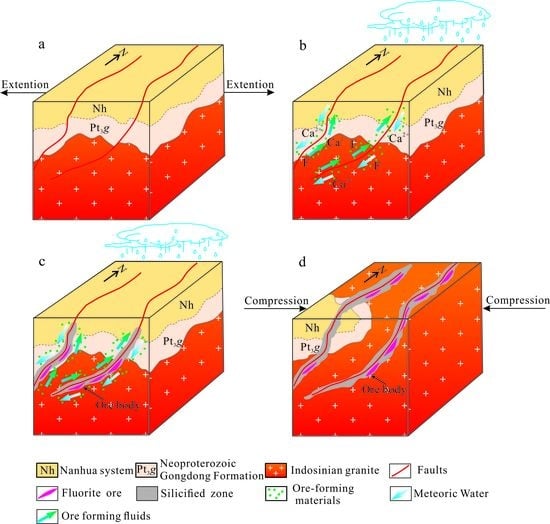Genetic Relationship between Granite and Fluorite Mineralization in the Shuanghuajiang Fluorite Deposit, Northern Guangxi, South China: Evidence from Geochronology, REE, and Fluid Geochemistry
Abstract
:1. Introduction
2. Regional Geologic Setting
3. Deposit Geology
4. Sampling and Analytical Methods
5. Results
5.1. Zircon U-Pb Dating
5.2. Fluorite Sm and Nd Isotopic Analysis
5.3. Rare Earth Elements (REE)
5.4. Fluid Inclusions
5.5. H-O Isotopic Compositions of the Fluid Inclusions
6. Discussion
6.1. Timing of Granitic Emplacement and Fluorite Mineralisation
6.2. Ore-Forming Fluids
6.3. Source of the Ore-Forming Materials
6.4. Model of Fluorite Mineralization
7. Conclusions
Author Contributions
Funding
Data Availability Statement
Conflicts of Interest
References
- Chen, J.Y.; Liu, Y.F.; Yan, L.Y.; Gao, S.X.; OuYang, Y.H.; Long, T. Research on development trend of strategic nonmetallic minerals such as graphite and fluorite. Acta Geosci. Sin. 2021, 42, 287–296, (In Chinese with English Abstract). [Google Scholar]
- Zou, H.; Li, M.; Santosh, M.; Zheng, D.; Cao, H.W.; Jiang, X.W.; Chen, H.F.; Li, Z.Q. Fault-controlled carbonate-hosted barite-fluorite mineral systems: The Shuanghe deposit, Yangtze Block, South China. Gondwana Res. 2022, 101, 26–43. [Google Scholar] [CrossRef]
- Wang, C.L.; Wang, J.Y.; You, C.; Yu, X.C.; Liu, D.H.; Yan, K.; Liu, S.H.; Xue, Y.; Liu, Y.T.; Liu, X.; et al. A study on strategic non-metallic mineral definition, key applications, and supply and demand situation. Acta Geosci. Sin. 2022, 43, 267–278, (In Chinese with English Abstract). [Google Scholar]
- Blengini, G.A.; Nuss, P.; Dewulf, J.; Nita, V.; Peiro, L.T.; Legaz, B.V.; Latunussa, C.; Mancini, L.; Blagoeva, D.; Pennington, D.; et al. EU methodology for critical raw materials assessment: Policy needs and proposed solutions for incremental improvements. Resour. Policy 2017, 53, 12–19. [Google Scholar] [CrossRef]
- Galos, K.; Lewicka, E.; Burkowicz, A.; Guzik, K.; Niewiadomska, A.K.; Kamyk, J.; Szlugaj, J. Approach to identification and classification of the key, strategic and critical minerals important for the mineral security of Poland. Resour. Policy 2021, 70, 101900. [Google Scholar] [CrossRef]
- Yi, J.H.; Dai, S.; Cheng, J.H.; Wu, Q.S.; Liu, K.L. Production quota policy in China: Implications for sustainable supply capacity of critical minerals. Resour. Policy 2021, 72, 102246. [Google Scholar] [CrossRef]
- Li, H.; Zhu, D.P.; Shen, L.W.; Algeo, T.J.; Elatikpo, S.M. A general ore formation model for metasediment-hosted Sb-(Au-W) mineralization of the Woxi and Banxi deposits in South China. Chem. Geol. 2022, 607, 121020. [Google Scholar] [CrossRef]
- Gao, B.; Chen, J.T.; Huang, X.; Xin, H.; Zheng, Q.F. Resolving the Tectonic Setting of South China in the Late Paleozoic. Geophys. Res. Lett. 2022, 15, 26–43. [Google Scholar] [CrossRef]
- Ministry of Natural Resources of the People’s Republic of China. China Mineral Resources; Geological Publishing House: Beijing, China, 2021; (In Chinese with English Abstract).
- Wang, J.P.; Shang, P.Q.; Xiong, X.X.; Yang, H.Y.; Tang, Y. The classification of fluorite deposits in China. Geol. China 2014, 41, 21–325. [Google Scholar]
- Wang, J.P.; Shang, P.Q.; Niu, G.Z. Discussion on China fluorite-concentrating area and the resource potentialhina. Geol. Chem. Miner. 2010, 32, 87–94. [Google Scholar]
- Cao, J.C. REE geochemical characteristics of epithermal vein fluorite deposits in South China. Geochimica 1995, 24, 225–234, (In Chinese with English Abstract). [Google Scholar]
- Han, B.B.; Shang, P.Q.; Gao, Y.Z.; Jiao, S.; Yao, C.M.; Zou, H.; Li, M.; Wang, L.; Zheng, H.Y. Fluorite deposits in China: Geological features, metallogenic regularity, and research progress. China Geol. 2020, 3, 473–489. [Google Scholar]
- Cao, J.C. Geological feature and mineralization of fluorite deposit related to granite in China. Geol. Prospect. 1994, 30, 1–6, (In Chinese with English Abstract). [Google Scholar]
- Yang, S.W. Genesis of Fluorite Deposits in Xingguo–Ningdu Metallogenic Belt Southern Jiangxi. Ph.D. Thesis, Chinese Academy of Geological Sciences, Beijing, China, 2019. (In Chinese with English Abstract). [Google Scholar]
- Liu, D.R. Geological Characteristics and Metallogenic Regularity of the Gaowushan–Jiaokengwu Fluorite Deposit in the Bamianshan Orefield, Chanshan County, Zhejiang Province. Master’s Thesis, China University of Geosciences, Beijing, China, 2013. (In Chinese with English Abstract). [Google Scholar]
- Li, K.K.; Wang, C.L.; Chen, L.X.; Wang, G.X.; Shang, P.Q.; Zhang, Q.S.; Liu, Z.Z.; Han, Z.K.; Yan, X.B.; Jiang, J.Y. Characteristics of trace and rare earth elements and direction for ore-forming materials in Shaowu area, Fujian Province. Geol. China 2020. Available online: https://kns.cnki.net/kcms/detail/11.1167.P.20200616.1107.010.html (accessed on 16 June 2020). (In Chinese with English Abstract).
- Wen, H.C.; Hou, G.Y. The geological characteristics controlled geological conditions and geneses of Nankeng fluorite deposit in Yongfeng Jiangxi province. J. Southwest Inst. Technol. 1993, 8, 55–63, (In Chinese with English Abstract). [Google Scholar]
- Yang, S.W.; Feng, C.Y.; Lou, S.F.; Zhang, F.R.; He, B.; Cao, Y.B. A preliminary study on metallogenic age and genesis of Longping fluorite deposit in southern Jiangxi Province: Evidence from Sm-Nd isochron dating of fluorite and electron probe of biotite. Geol. J. China Univ. 2019, 25, 341–351, (In Chinese with English Abstract). [Google Scholar]
- Chang, S.M. Study on Geological Characteristics and Metallogenic Regularity of Fluorite Ore Deposits in the Huaiyuand Northern Wuyi Mountains, Jiangxi Province. Master’s Thesis, Nanjing University, Nanjing, China, 2017. (In Chinese with English Abstract). [Google Scholar]
- Zhang, Z.Z.; Gong, Y.J.; Chen, L.B.; Huang, C.J.; Gan, J.M. Geochemical evidence of the source of ore-forming materials from Dazhuyuan fluorite deposit in northeastern Guizhou. Geochimica 2018, 47, 295–305, (In Chinese with English Abstract). [Google Scholar]
- Xia, X.H.; Han, Y.C.; Lian, W.; Yuan, C.J.; Xu, S.K.; Yan, F.; Liang, Z.P. Sedimentary Genesis Feature of Bamianshan Unusual Large Fluorite Deposit in Zhejiang Province. Acta Sedimentol. Sin. 2010, 28, 1175–1181, (In Chinese with English Abstract). [Google Scholar]
- Han, Y.C.; Xia, X.H.; Pang, S.Y.; Xu, S.K. Hydrothermal sedimentary mineralization of the super-large Bamianshan fluorite deposit in Zhejiang Province, China. Acta Geol. Sin. 2012, 86, 762–768. [Google Scholar]
- Liu, D.R. Genesis of Fluorite Deposits and Prospecting Direction in Northwestern Zhejiang Province. Geol. Explor. 2017, 53, 947–959, (In Chinese with English Abstract). [Google Scholar]
- Wang, X.L.; Wang, S.; Yuan, Y.W.; Li, Y.Q. Characteristics of geological and metallogenic fluids on Bancang fluorite mine in Dawu, Hubei. Miner. Explor. 2019, 10, 2256–2260, (In Chinese with English Abstract). [Google Scholar]
- Huang, W.T.; Wu, J.; Zhang, J.; Liang, H.Y.; Qiu, X.L. Geochemistry and Hf–Nd isotope characteristics and forming processes of the Yuntoujie granites associated with W–Mo deposit, Guangxi, South China. Ore Geol. Rev. 2017, 81, 953–964. [Google Scholar] [CrossRef]
- Wei, G.H.; Nong, S.H.; Wu, J.; Liang, H.Y.; Chen, X.L.; Che, J.; Liu, X. Study on the characteristics of ore-forming fluid and formation of the Niutangjie tungsten deposit in northern Guangxi, China. Geochimica 2018, 47, 675–684, (In Chinese with English Abstract). [Google Scholar]
- Zhu, Y.T.; Li, X.F.; Xiao, R.; Yu, Y.; Wang, C.Z. Multistage magmatic-hydrothermal activity and W-Cu mineralization at Jiepai, Guangxi Zhuang Autonomous Region, South China: Constraints from geochronology and Nd-Sr-Hf-O isotopes. Ore Geol. Rev. 2020, 121, 103492. [Google Scholar] [CrossRef]
- Du, Y.; Tian, L.; Zheng, Z.F.; Chen, J.F.; Zhang, X.Q.; Wang, J.Y.; Zhou, L.T.; Fan, H.; Li, C. Sm-Nd dating of scheelite in Luojiachong W-Sn deposit, Miaoershan area, southwestern Hunan Province: Implications for polycyclic tectonic-magmatic activities and metallogenesis in South China. Geol. Bull. China 2022, 41, 886–902, (In Chinese with English Abstract). [Google Scholar]
- Wang, J.P.; Shang, P.Q.; Xiong, X.X.; Yang, H.Y.; Tang, T. Metallogenic regularities of fluorite deposits in China. Geol. China 2015, 42, 18–32, (In Chinese with English Abstract). [Google Scholar] [CrossRef]
- Hu, H.; Wang, R.C.; Chen, W.F.; Chen, P.R.; Ling, H.F.; Liu, G.N. Timing of hydrothermal activity associated with the Douzhashan uranium-bearing granite and its significance for uranium mineralization in northeastern Guangxi, China. Chin. Sci. Bull. 2013, 58, 4319–4328. [Google Scholar] [CrossRef] [Green Version]
- Wu, J.; Liang, H.Y.; Huang, W.T.; Wang, C.L.; Sun, W.D.; Sun, Y.L.; Li, J.; Mo, J.H.; Wang, X.Z. Indosinian isotope ages of plutons and deposits in southwestern Miaoershan–Yuechengling, northeastern Guangxi and implications on Indosinian mineralization in South China. Chin. Sci. Bull. 2012, 57, 1126–1136. [Google Scholar] [CrossRef]
- Huang, W.T.; Wu, J.; Liang, H.Y.; Zhang, J.; Ren, L.; Chen, X.L. Ages and genesis of W-Sn and Ta-Nb-Sn-W mineralization associated with the Limu granite complex, Guangxi, China. Lithos 2020, 352–353, 105321. [Google Scholar] [CrossRef]
- Li, F.S.; Zhou, H.X. The characteristics and its fixed position mechanism of granite unit and super-unit of Miaoer Mountain. Hunan Geol. 2002, 21, 20–25, (In Chinese with English Abstract). [Google Scholar]
- Yang, Z.; Zhang, W.L.; Wang, R.C.; Lu, J.J.; Xie, L.; Che, X.D. Geochronology and geochemical characteristics of metallogenetic pluton in the Youmaling tungsten mining area, northern Guangxi province, and its geological significance. Geol. J. China Univ. 2013, 19, 159–172, (In Chinese with English Abstract). [Google Scholar]
- Hu, H.; Wang, R.C.; Chen, W.F.; Ding, H.H.; Ling, H.F.; Chen, P.R.; Liu, G.R. Characteristics of Biotite in Uranium-and Non-uranium-bearing Granites from Northeastern Guangxi Province, China: Implications on Uranium Mineralization. Acta Mineral. Sin. 2014, 34, 321–327, (In Chinese with English Abstract). [Google Scholar]
- Bai, D.Y.; Zhong, X.; Jia, P.Y.; Xiong, X.; Huang, W.Y. Zircon SHRIMP U-Pb dating and geochemistry of Caledonian Miaoershan pluton in the western part of the Nanling Mountains and their tectonic significance. Acta Petrol. Mineral. 2014, 33, 407–423, (In Chinese with English Abstract). [Google Scholar]
- Li, W.W.; Wang, G.; Chen, W.F.; Zhao, K.D. Geochemical characteristics and geological implications of Xiangcaoping granite pluton in Miaoershan area. Uranium Geol. 2010, 26, 215–221, (In Chinese with English Abstract). [Google Scholar]
- Wang, Z.Q. Study on Metallogenic Mechanism of Miaoershan Granite-Type Uranium Deposit in Guangxi. Ph.D. Thesis, Beijing Research Institute of Uranium Geology, Beijing, China, 2018. (In Chinese with English Abstract). [Google Scholar]
- Ludwig, K.R. Isoplot/Ex, a geochronological toolkit for Microsoft Excel, Version 3.00. Berkeley Geochronology Center. Berkeley Geochronol. Cent. Spec. Publ. 2003, 4, 1–70. [Google Scholar]
- Peng, J.T.; Hu, R.Z.; Burnard, P.G. Samarium–neodymium isotope systematics of hydrothermal calcites from the Xikuangshan antimony deposit (Hunan, China): The potential of calcite as a geochronometer. Chem. Geology. 2003, 200, 120–136. [Google Scholar] [CrossRef]
- Bell, K.; Anglin, C.D.; Franklin, J.M. Sm-Nd and Rb-Sr isotope systematics of scheelites: Possible implications for the age and genesis of vein-hosted gold deposits. Geology 1989, 17, 500–504. [Google Scholar] [CrossRef]
- Gao, S.; Liu, X.M.; Yuan, H.L.; Hattendorf, B.; Gunther, D.; Chen, L.; Hu, S.H. Determination of forty-two major and trace elements in USGS and NIST SRM glasses by laser ablation-inductively coupled plasma-mass spectrometry. Geostand. Geoanal. Res. 2007, 26, 181–196. [Google Scholar] [CrossRef]
- Clayton, R.N.; Mayeda, T.K. The use of bromine pentafluoride in the extraction of oxygen from oxides and silicates for isotopic analysis. Geochim. Cosmochim. Acta. 1963, 27, 43–52. [Google Scholar] [CrossRef]
- Belousova, E.; Griffin, W.; O’reilly, S.Y.; Fisher, N. Igneous zircon: Trace element composition as an indicator of source rock type. Contrib. Miner. Petrol. 2002, 143, 602–622. [Google Scholar] [CrossRef]
- Hoskin, P.; Black, L.P. Metamorphic zircon formation by solid-state recrystallization of protolith Igneous Zircon. J. Metamorph. Geol. 2010, 18, 423–439. [Google Scholar] [CrossRef]
- Hall, D.L.; Sterner, S.M.; Bodnar, R.J. Freezing point depression of NaCl-KCl-H2O solutions. Econ. Geol. 1988, 83, 197–202. [Google Scholar] [CrossRef]
- Ohmoto, H.; Rye, R.O. Hydrogen and oxygen isotopic compositions of fluid inclusions in the Kuroko deposits, Japan. Econ. Geol. 1974, 69, 947–953. [Google Scholar] [CrossRef]
- Richardson, C.K.; Rye, R.O.; Wasserman, M.D. The chemical and thermal evolution of the fluids in the Cave-In-Rock fluorspar district, Illinois: Stable isotope systematics at the Deardorff mine. Econ. Geol. 1988, 83, 765–783. [Google Scholar] [CrossRef]
- Xie, X.H.; Chen, W.F.; Zhao, K.D.; Sun, T.; Chen, P.R.; Jiang, S.Y.; Zhu, K.R.; Li, W.W. Geochemical characteristics and geochronology of the Douzhashan granite, northeastern Guangxi Province, China. Acta Petrol. Sin. 2008, 24, 1302–1312, (In Chinese with English Abstract). [Google Scholar]
- Li, C.J.; Xu, B.T.; Jiang, X.L.; Hu, Y.H. Time interval between the formation of host rock and the mineralization in some hydrothermal deposits of Southeast China with a discussion on some related problems. Miner. Depos. 1992, 11, 106–112+105, (In Chinese with English Abstract). [Google Scholar]
- Fang, G.C.; Wang, D.H.; Chen, Y.C.; Huang, F.; Wang, Y.; Wu, J.X.; Hu, S.F. Metallogenic regularities and genesis of the fluorite deposits in Nanling region. Acta Geol. Sin. 2020, 97, 161–178, (In Chinese with English Abstract). [Google Scholar]
- Xu, Y.H. Research on the Fluorite Metallogenic Geological Conditions and Prognosis in Gannan Area. Ph.D. Thesis, China University of Geosciences, Beijing, China, 2008. (In Chinese with English Abstract). [Google Scholar]
- Li, X.F.; Feng, Z.H.; Xiao, R.; Song, C.A.; Yang, F.; Wang, C.Y.; Kang, Z.Q.; Mao, W. Spatial and Temporal Distributions and the Geological Setting of the W-Sn-Mo-Nb-Ta Deposits at the Northeast Guangxi, Southe China. Acta Geol. Sin. 2012, 86, 1713–1725, (In Chinese with English Abstract). [Google Scholar]
- Zhang, D.X.; Pan, J.Q.; Gao, J.F.; Dai, T.G.; Bayless, R.C. In situ LA ICP-MS analysis of trace elements in scheelite from the Xuefeng Uplift Belt, South China and its metallogenic implications. Ore Geol. Rev. 2021, 133, 104097. [Google Scholar] [CrossRef]
- Li, J.D.; Li, X.F.; Xiao, R. Multiple-stage tungsten mineralization in the Silurian Jiepai W skarn deposit, South China: Insights from cathodoluminescence images, trace elements, and fluid inclusions of scheelite. J. Asian Earth Sci. 2019, 181, 103898. [Google Scholar] [CrossRef]
- Zhang, D.; Zhang, W.L.; Wang, R.C.; Chu, Z.Y.; Gong, M.W.; Jiang, G.X. Quartz-vein Type Tungsten Mineralization Associated with the Indosinian (Triassic) Gaoling Granite, Miao’ershan Area, Northern Guangxi. Geol. Rev. 2015, 61, 817–834, (In Chinese with English Abstract). [Google Scholar]
- Chen, W.D.; Zhang, W.L.; Wang, R.C.; Chu, Z.Y.; Xiao, R.; Zhang, D.; Che, X.D. A study on the Dushiling tungsten-copper deposit in the Miao’ershan-Yuechengling area, Northern Guangxi, China: Implications for variations in the mineralization of multi-aged composite granite plutons. Sci. Sin. 2016, 46, 1602–1625. [Google Scholar] [CrossRef]
- Ye, X.F. Mineralization and Metallogenic Model of Fluorite Deposits in the Zhejiang Area. Northwestern Geol. 2014, 47, 208–220, (In Chinese with English Abstract). [Google Scholar]
- Hua, R.M.; Chen, P.R.; Zhang, W.L.; Yao, J.M.; Lin, J.F.; Zhang, S.Z.; Gu, S.Y. Metallogeneses and Their Geodynamic Settings Related to Mesozoic Granitoids in the Nanling Range. Geol. J. China Univ. 2005, 11, 291–304, (In Chinese with English Abstract). [Google Scholar]
- Li, X.H.; Li, W.X.; Li, Z.X. Discussing the origin of the early Yanshanian granite and its tectonic significanceagain, in Nanling region. Chin. Sci. Bull. 2007, 52, 981–991, (In Chinese with English Abstract). [Google Scholar]
- Cheng, S.B.; Fu, J.M.; Ma, Y.L.; Lu, Y.Y.; Wang, X.D.; Xia, J.L. Early Jurassic Iron-Tin Mineralization Event in the Nanling Range: Evidence from LA-ICP-MS Zircon U-Pb and Phlogopite 39 Ar-40 Ar Dating of the Dading Deposit in Lianping, Northern Guangdong. Acta Geol. Sin. 2016, 90, 163–176, (In Chinese with English Abstract). [Google Scholar]
- Zhou, Z.M.; Ma, C.Q.; Wang, L.X.; Chen, S.G.; Xie, C.F.; Li, Y.; Liu, W. A source-depleted Early Jurassic granitic pluton from South China: Implication to the Mesozoic juvenile accretion of the South China crust. Lithos 2018, 300, 278–290. [Google Scholar] [CrossRef]
- Jia, X.H.; Wang, X.D.; Yang, W.Q.; Niu, Z.J. The early Jurassic A-type granites in North Guangxi, China: Petrogenesis and implications. Earth Sci.-J. China Univ. Geosci. 2014, 39, 21–36, (In Chinese with English Abstract). [Google Scholar]
- Bai, D.Y.; Zhong, X.; Jia, P.Y.; Xiong, X. Geochemistry and tectonic setting of the early Yanshanian granites in the Miaoershan area, southwest Hunan Province. Resour. Surv. Environ. 2015, 36, 235–243, (In Chinese with English Abstract). [Google Scholar]
- Ma, C.A. Study on mineral inclusions of fluorite deposits in Wuyi, Zhejiang Prov. J. Nanjing Inst. Geol. Miner. Resour. 1990, 11, 13–24, (In Chinese with English Abstract). [Google Scholar]
- Zhang, S.T.; Cao, H.W.; Zheng, G.; Ma, Y.; Fang, Y.; Zou, H. Characteristics of ore-forming fluids and mineralization processes of the Shuitou fluorite deposit in Linxi, Inner Mongolia Autonomous Region. Earth Sci. Front. 2014, 21, 31–40, (In Chinese with English Abstract). [Google Scholar]
- Bau, M. Rare-earth element mobility during hydrothermal and metamorphic fluid-rock interaction and the significance of the oxidation state of europium. Chem. Geol. 1991, 93, 219–230. [Google Scholar] [CrossRef]
- Schwinn, G.; Markl, G. REE systematics in hydrothermal fluorite. Chem. Geol. 2005, 216, 225–248. [Google Scholar] [CrossRef]
- Mahdy, N.M.; Shalaby, M.H.; Helmy, H.M.; Osman, A.F.; EI Sawey, E.S.H.; Zeib, E.K.A. Trace and REE element geochemistry of fluorite and its relation to uranium mineralization, Gabal Gattar Area, Northern Eastern Desert, Egypt. Arab. J. Geosci. 2014, 7, 2573–2589. [Google Scholar] [CrossRef]
- Dong, W.C.; Pang, X.C.; Si, Y.Y.; Liang, Z.; Li, W.M. REE Geological Characteristics of Checun Fluorite Deposit in Song County, Henan Province. J. Chin. Soc. Rare Earths 2020, 38, 706–714, (In Chinese with English Abstract). [Google Scholar]
- Möller, P.; Parekh, P.P.; Schneider, H.J. The application of Tb/Ca-Tb/La abundance ratios to problems of fluorspar genesis. Miner. Depos. 1976, 11, 111–116. [Google Scholar] [CrossRef]
- Graupner, T.; Mühlbach, C.; Schwarz-Schampera, U.; Henjes-Kunst, F.; Melcher, F.; Terblanche, H. Mineralogy of high-field-strength elements (Y, Nb, REE) in the world-class Vergenoeg fluorite deposit, South Africa. Ore Geol. Rev. 2015, 64, 583–601. [Google Scholar] [CrossRef]
- Zhu, L.G.; Jin, S.; Wang, C.L.; Shang, P.Q.; Gao, L.Y.; Wang, Z.B. Geochemistry characteristic and genesis of surrounding rock and ore in Pucheng fluorite deposits district, Fujian Province. Acta Petrol. Mineral. 2021, 40, 923–938, (In Chinese with English Abstract). [Google Scholar]
- Taylor, H.P. The application of oxygen and hydrogen isotope studies to problems of hydrothermal alteration and ore deposition. Econ. Geol. 1974, 69, 843–883. [Google Scholar] [CrossRef]
- Xu, Z.G.; Tao, Y.K.; Xie, J.Y. Volcanic Geology and Mineral Resources of Southeast China Continent; Geological Publishing House: Beijing, China, 1997; (In Chinese with English Abstract). [Google Scholar]
- Cao, J.C. Hydrogen and oxygen isotopic elements of fluorite gas-liquid inclusions in hydrothermal vein type fluorite deposits. Geol. Prospect. 1994, 30, 28–29, (In Chinese with English Abstract). [Google Scholar]
- Fang, Y.; Zou, H.; Bagas, L.; Said, N.; Li, Y.; Liu, H. Fluorite deposits in the Zhejiang Province, Southeast China: The possible role of extension during the late stages in the subduction of the Paleo-Pacific oceanic plate, as indicate by the Gudongkeng fluorite deposit. Ore Geol. Rev. 2020, 117, 122–136. [Google Scholar] [CrossRef]
- Zhu, J.B.; Wang, J.P.; Shang, P.Q.; Shi, Q.Y. Geochemical characteristics of strontium and hydrogen and oxygen isotopes in fluorite deposits in China. Geol. Chem. Miner. 2021, 43, 7–16, (In Chinese with English Abstract). [Google Scholar]
- Sheppard, S.M. Characterization and Isotopic Variations in Natural Waters. Rev. Mineral. Geochem. 1986, 16, 165–183. [Google Scholar]
- González-Partida, E.; Carrillo-Chávez, A.; Grimmer, J.O.W.; Pironon, J.; Mutterer, J.; Levresse, G. Fluorite deposits at Encantada–Buenavista, Mexico: Products of Mississippi Valley type processes. Ore Geol. Rev. 2003, 23, 107–124. [Google Scholar] [CrossRef]
- Levresse, G.; Tritlla, J.; Villareal, J.; Gonzalez-Partida, E. The “El Pilote” fluorite skarn: A crucial deposit in the understanding and interpretation of the origin and mobilization of F from northern Mexico deposits. J. Geochem. Explor. 2006, 89, 205–209. [Google Scholar] [CrossRef]
- Borrok, D.M.; Kelser, S.E.; Boer, R.H.; Essene, E.J. The Vergenoeg magnetite-fluorite deposit, South Africa; support for a hydrothermal model for massive iron oxide deposits. Econ. Geol. 1998, 93, 564–586. [Google Scholar] [CrossRef]
- Bau, M.; Romer, R.L.; Lüders, V.; Dulski, P. Tracing element sources of hydrothermal mineral deposits: REE and Y distribution and Sr-Nd-Pb isotopes in fluorite from MVT deposits in the Pennine orefield, England. Miner. Depos. 2003, 38, 992–1008. [Google Scholar] [CrossRef]
- Brugger, J.; Etschmann, B.; Pownceby, M.; Liu, W.H.; Grundler, P.; Brewe, D. Oxidation state of europium in scheelite: Tracking fluid-rock interaction in gold deposits. Chem. Geol. 2008, 257, 26–33. [Google Scholar] [CrossRef]
- Li, H.; Kong, H.; Guo, B.Y.; Tamehe, L.S.; Zhang, Q.; Wu, Q.H.; Xi, X.S. Fluid inclusion, H–O–S isotope and rare earth element constraints on the mineralization of the Dong’an Sb deposit, South China. Ore Geol. Rev. 2020, 126, 103759. [Google Scholar] [CrossRef]
- Wood, S.A. The aqueous geochemistry of the rare earth elements and yttrium: 1. Review of available low-temperature data for inorganic complexes and the inorganic REE speciation of natural waters. Chem. Geol. 1990, 82, 159–186. [Google Scholar] [CrossRef]
- Wood, S.A. The aqueous geochemistry of the rare-earth elements and yttrium: 2. Theoretical predictions of speciation in hydrothermal solutions to 350 °C at saturation water vapor pressure. Chem. Geol. 1990, 88, 99–125. [Google Scholar] [CrossRef]
- Granitoid Research Group of Nanling Project. Geology of Granitoids of Nanling Region and Their Petrogenesis and Mineralization; Geological Publishing House: Beijing, China, 1989; (In Chinese with English Abstract). [Google Scholar]
- Rubinstein, N.A.; Zappettini, E.O. Origin and age of rift related fluorite and manganese deposits from the San Rafael Massif, Argentina. Ore Geol. Rev. 2015, 66, 334–343. [Google Scholar] [CrossRef]
- Pei, Q.M.; Zhang, S.T.; Santosh, M.; Cao, H.W.; Zhang, W.; Hu, X.K.; Wang, L. Geochronology, geochemistry, fluid inclusion and C, O and Hf isotope compositions of the Shuitou fluorite deposit, Inner Mongolia, China. Ore Geol. Rev. 2017, 83, 174–190. [Google Scholar] [CrossRef]
- Sami, M.; Ntaflos, T.; Farahat, E.S.; Mohamed, H.A.; Ahmed, A.F.; Hauzenberger, C. Mineralogical, geochemical and Sr-Nd isotopes characteristics of fluorite-bearing granites in the Northern Arabian-Nubian Shield, Egypt: Constraints on petrogenesis and evolution of their associated rare metal mineralization. Ore Geol. Rev. 2017, 88, 1–22. [Google Scholar] [CrossRef]
- Han, W.B. Geology and Geochemical Characteristics of Fluorite Deposits-with Wuyi Orefield in Zhejiang Province as an Example; Geological Publishing House: Beijing, China, 1991; (In Chinese with English Abstract). [Google Scholar]
- Zhang, B.D.; Xie, B.R.; Dai, Y.S. The analysis and calculation of metallogenic heat source for granite-type uranium deposits in South China. Miner. Depos. 1990, 9, 270–278, (In Chinese with English Abstract). [Google Scholar]
- Zhou, Z.M. Late Mesozoic Polycyclic Tectono-Magmatic Evolution and Forming Mechanism of the Geothermal Systems in South China-New Constraints from Typical Plutons in Guangdong Provine. Ph.D. Thesis, China University of Geosciences, Beijing, China, 2015. (In Chinese with English Abstract). [Google Scholar]
- Lu, X.Q. Discussion on metallogenic heat source of fluorite deposit in Hushan, Zhejiang Province. Zhejiang Land Resour. 2006, 2, 42–45. [Google Scholar]
- Deloule, E. The genesis of fluorspar hydrothermal deposits at Montroc and Le Burc, the Tarn, as deduced from fluid inclusion analysis. Econ. Geol. 1982, 77, 1867–1874. [Google Scholar] [CrossRef]
- Duan, Z.P.; Jiang, S.Y.; Su, H.M.; Zhu, X.H.; Jiang, B.B. Textural features and in situ trace element analysis of fluorite from the Wujianfang fluorite deposit, Inner Mongolia (NE China): Insights into fluid metasomatism and ore-forming process. Ore Geol. Rev. 2021, 147, 104982. [Google Scholar] [CrossRef]
- Chen, F.; Yan, D.P.; Qiu, L.; Yang, W.X.; Tang, S.L.; Guo, Q.Y.; Zhang, Y.X. The brittle-ductile shearing and uranium metallogenesis of the Motinaling dome in the southwestern Jiangnan Orogenic Belt. Acta Petrol. Sinica 2019, 35, 2637–2659, (In Chinese with English Abstract). [Google Scholar]
- Chu, Y.; Lin, W.; Faure, M.; Xue, Z.H.; Ji, W.B.; Feng, Z.T. Cretaceous episodic extension in the South China Block, East Asia: Evidence from the Yuechengling Massif of Central South China. Tectonics 2019, 38, 3675–3702. [Google Scholar] [CrossRef]

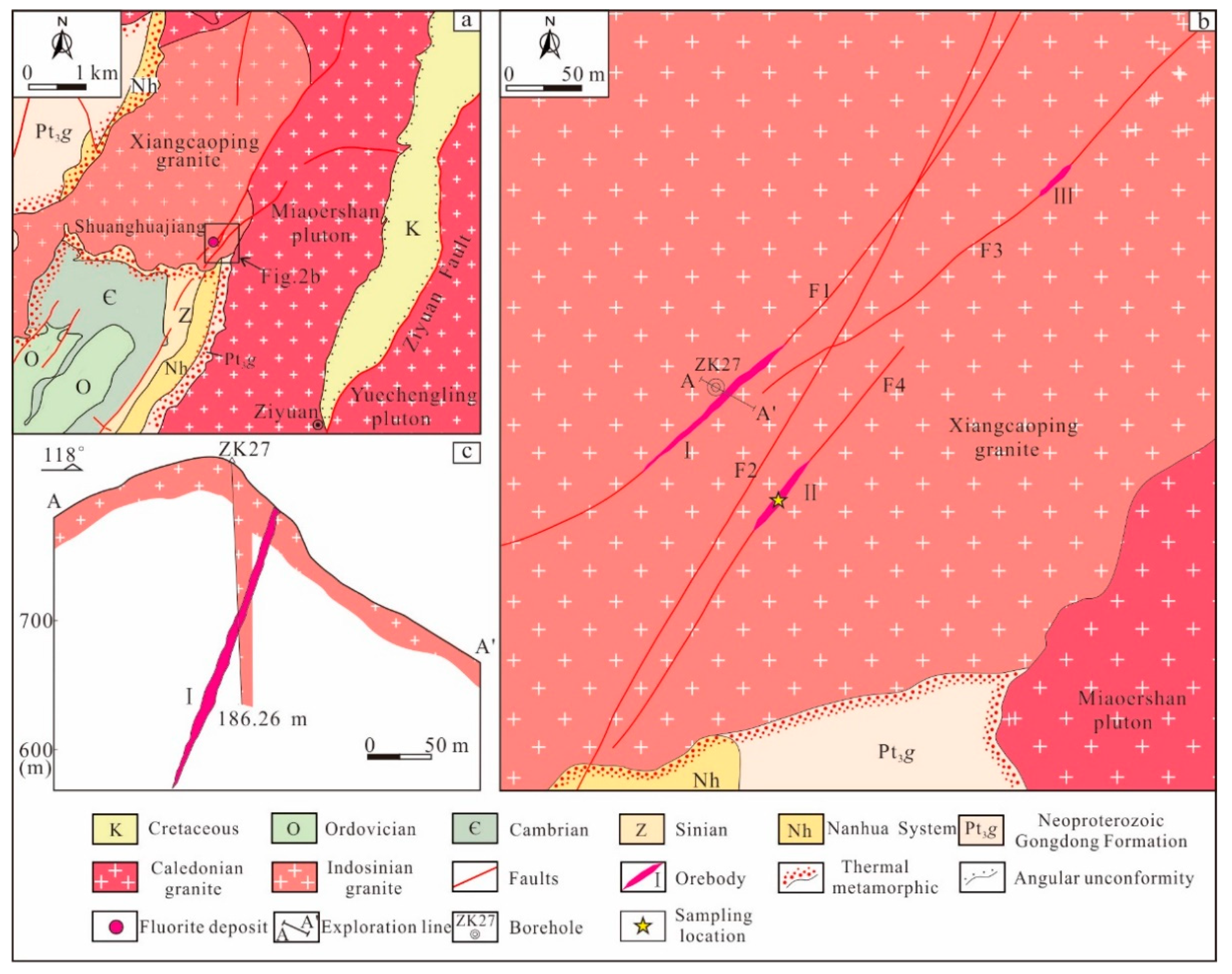
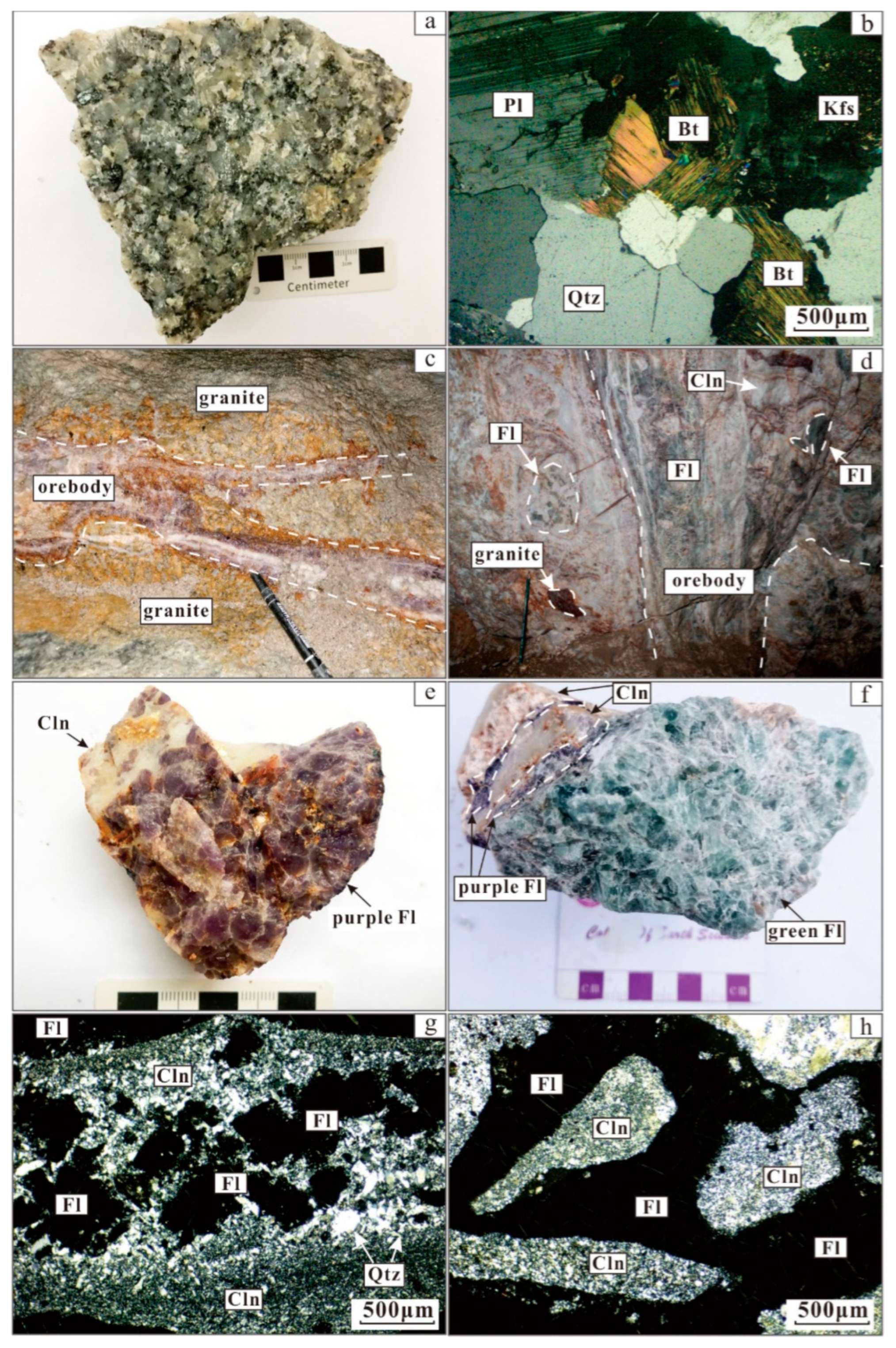

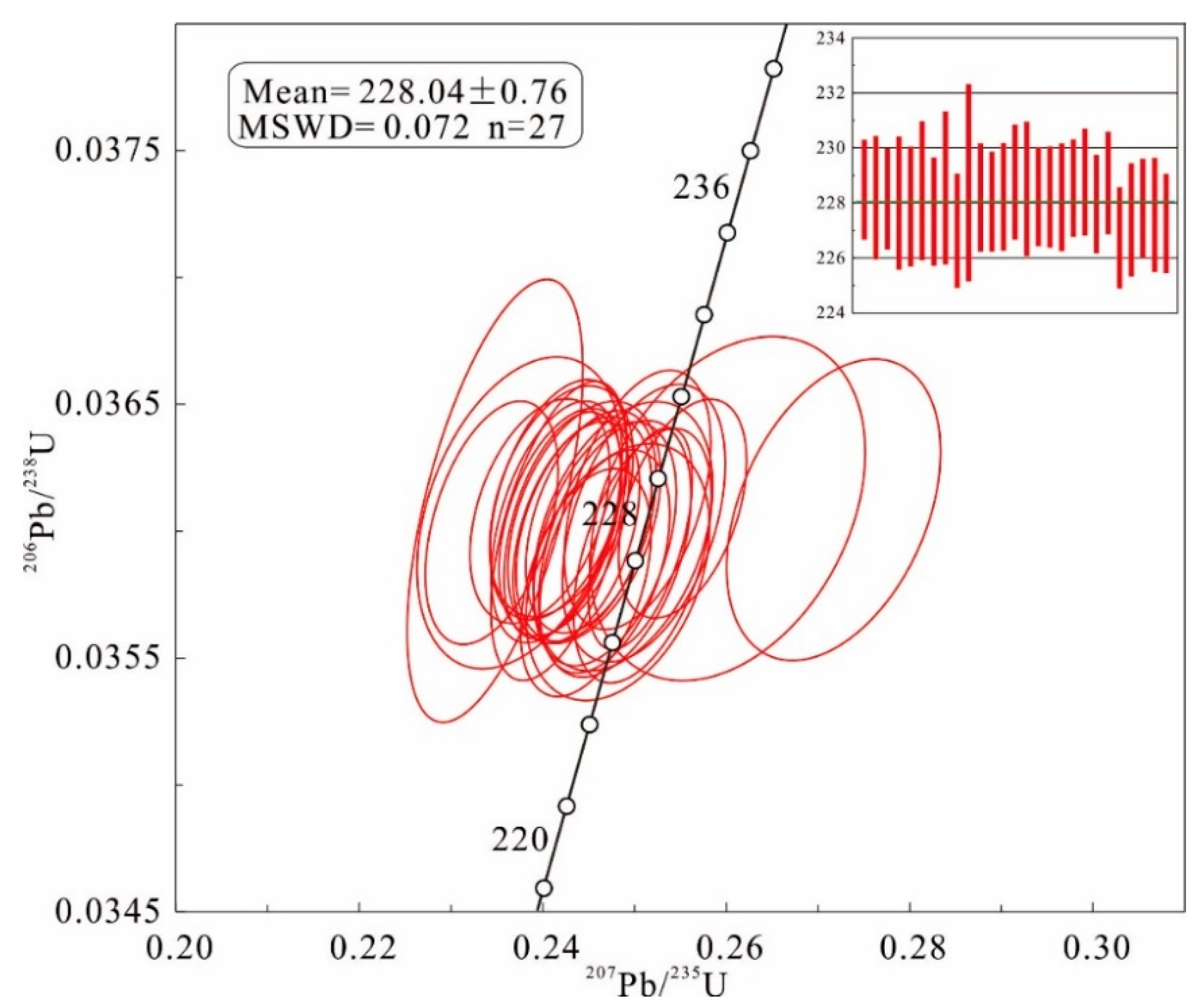
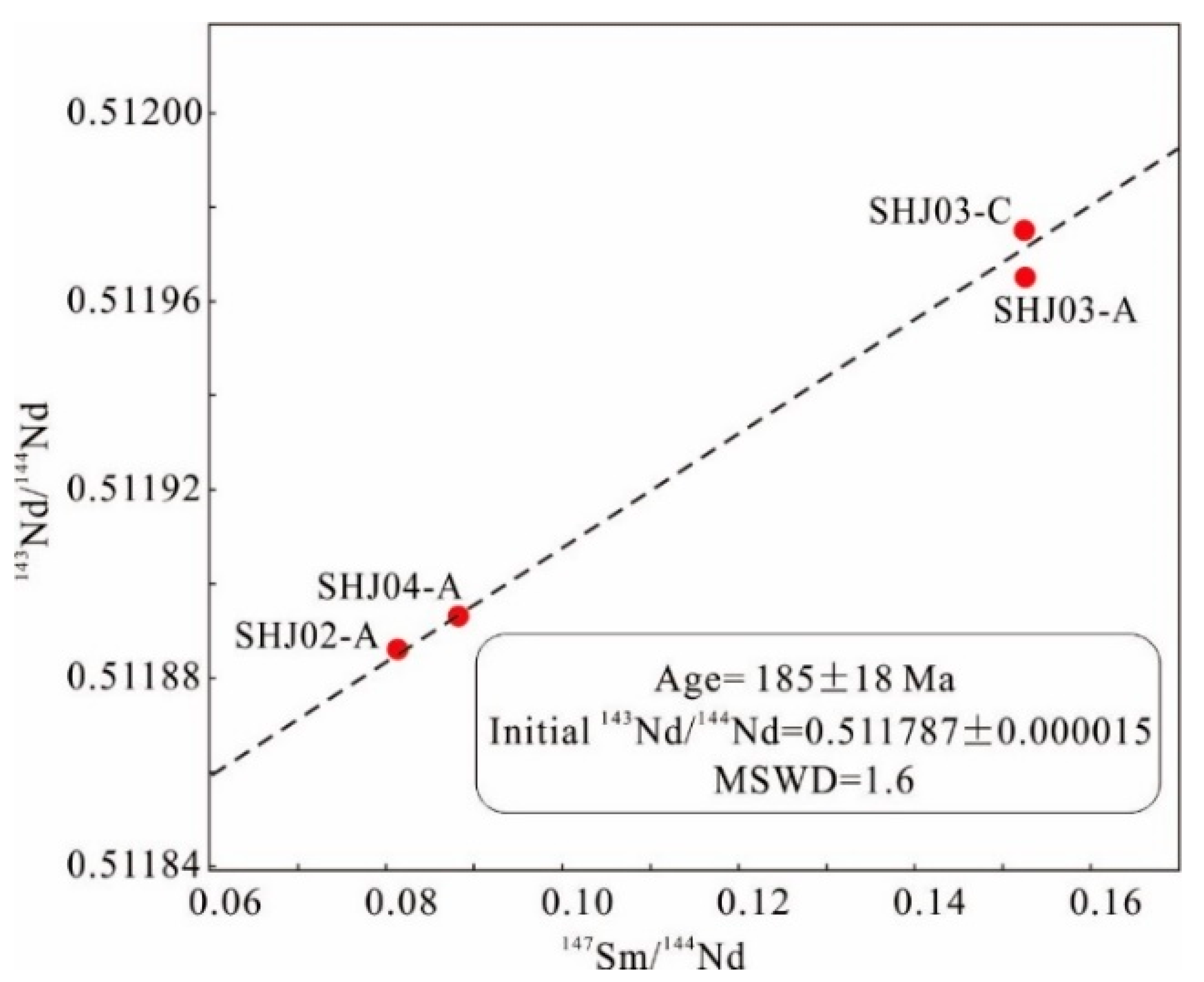

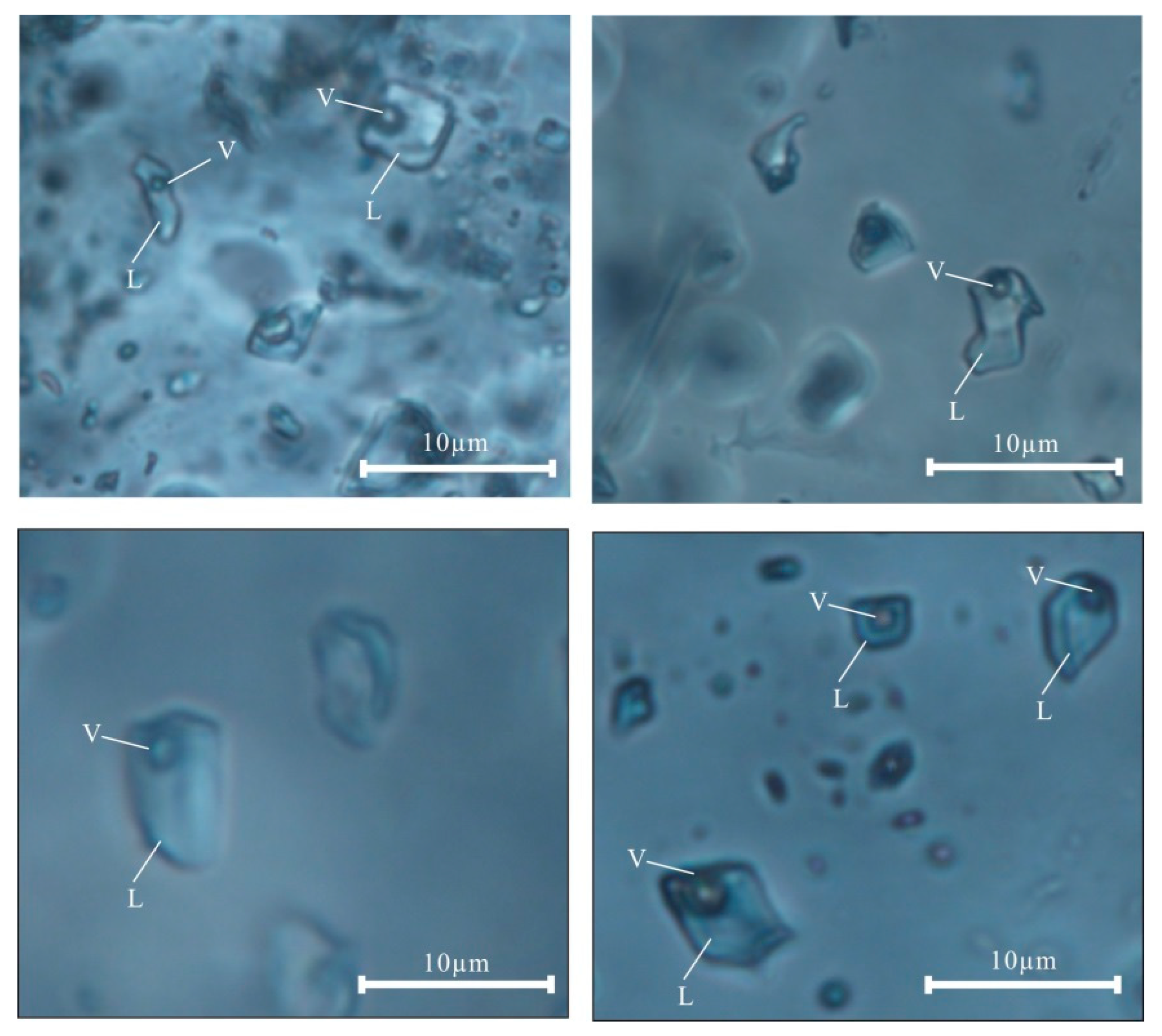
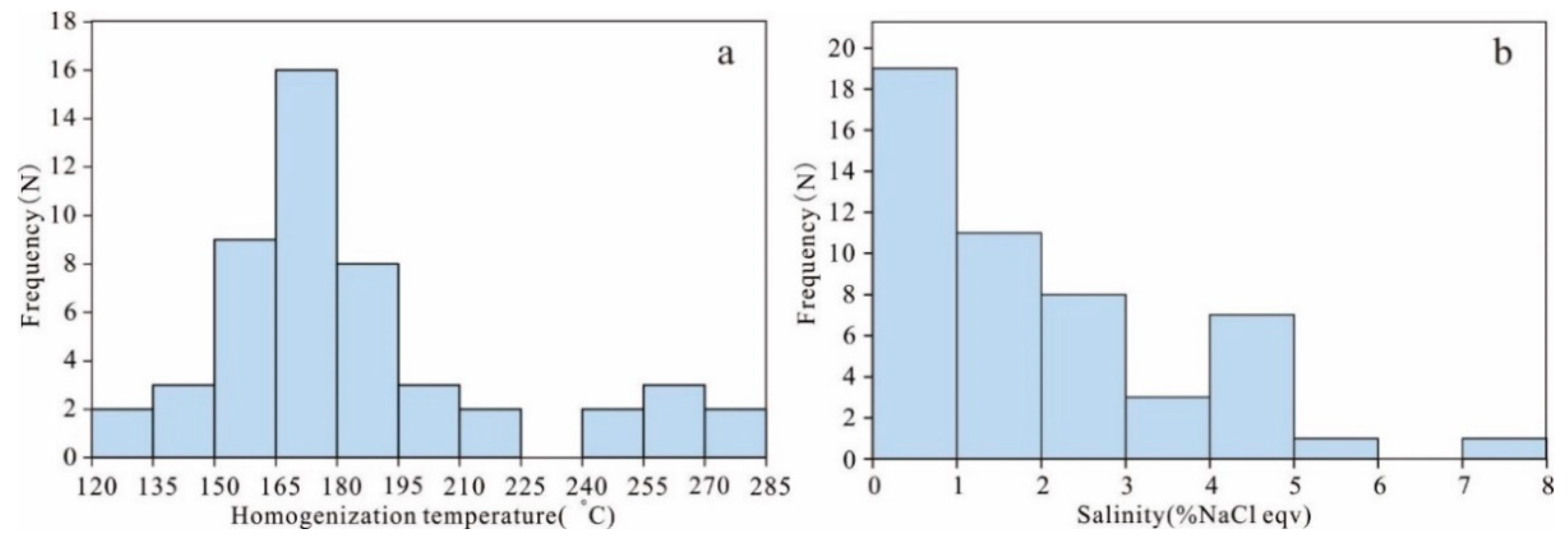
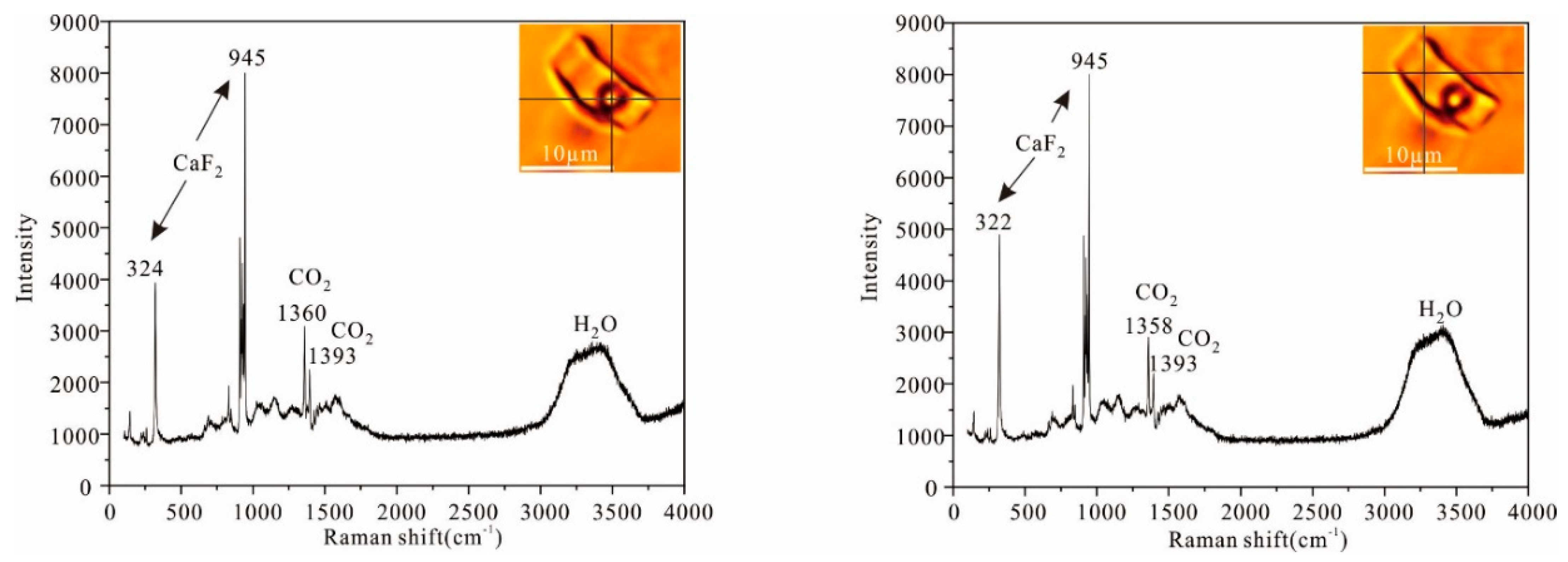
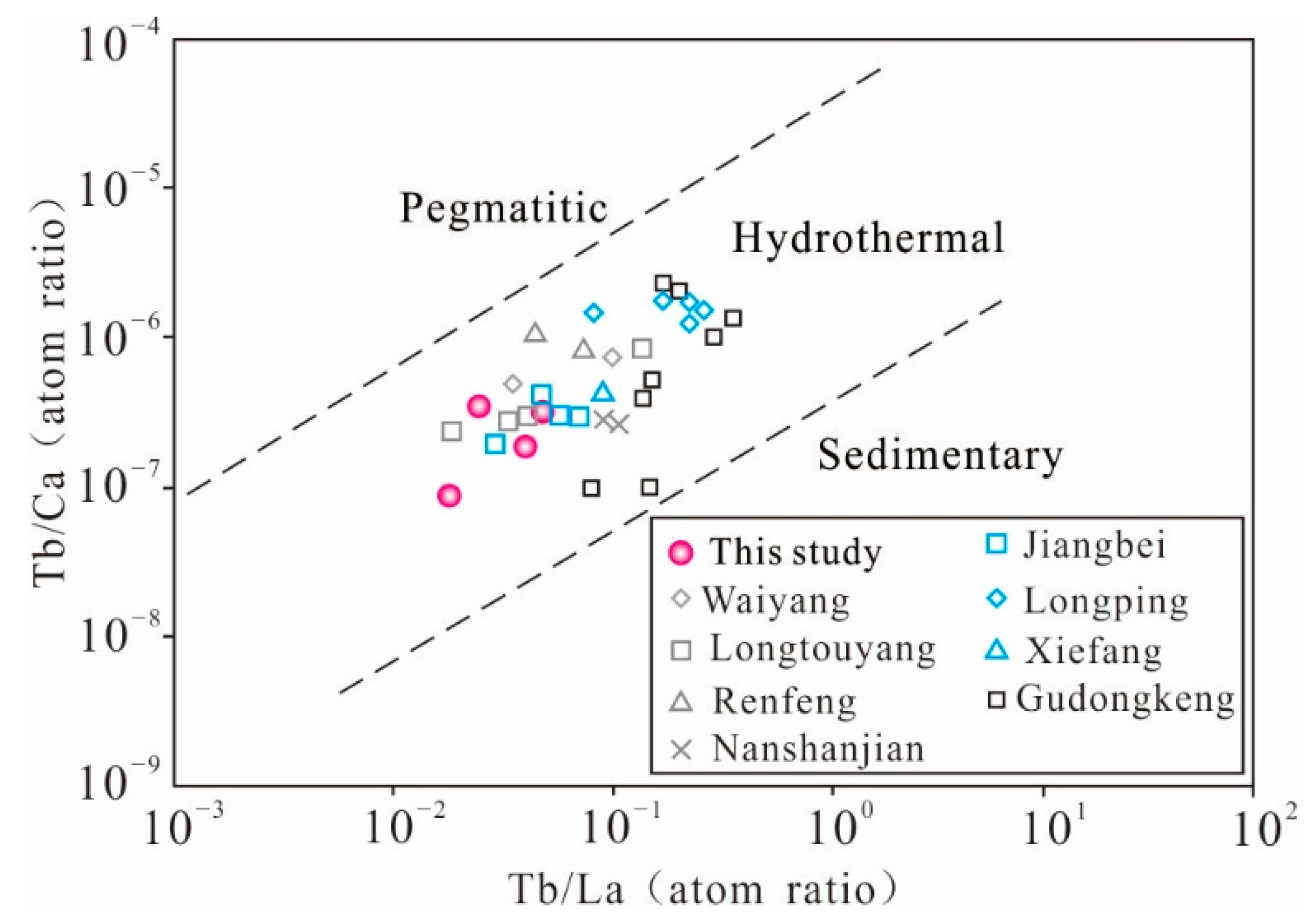
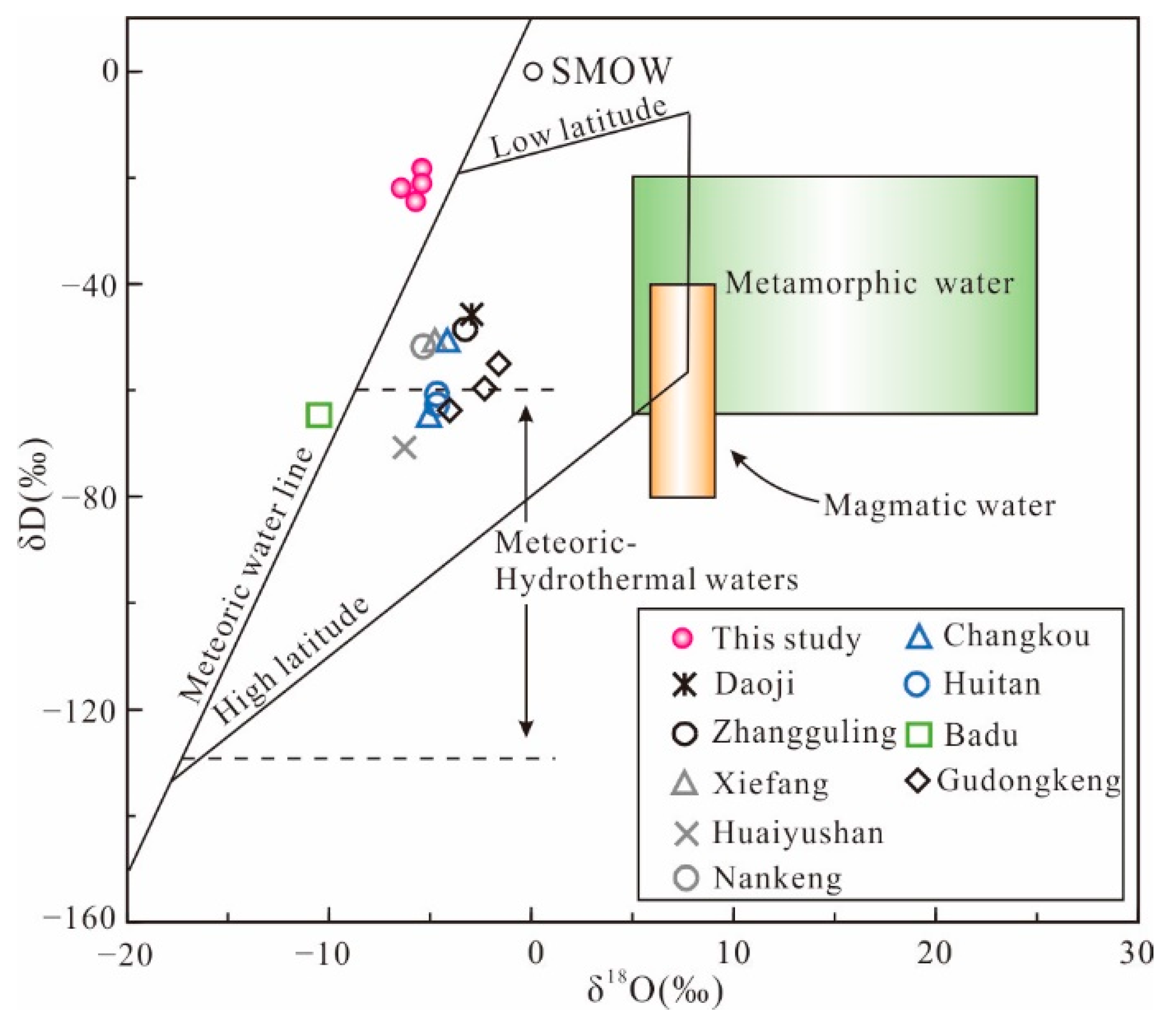
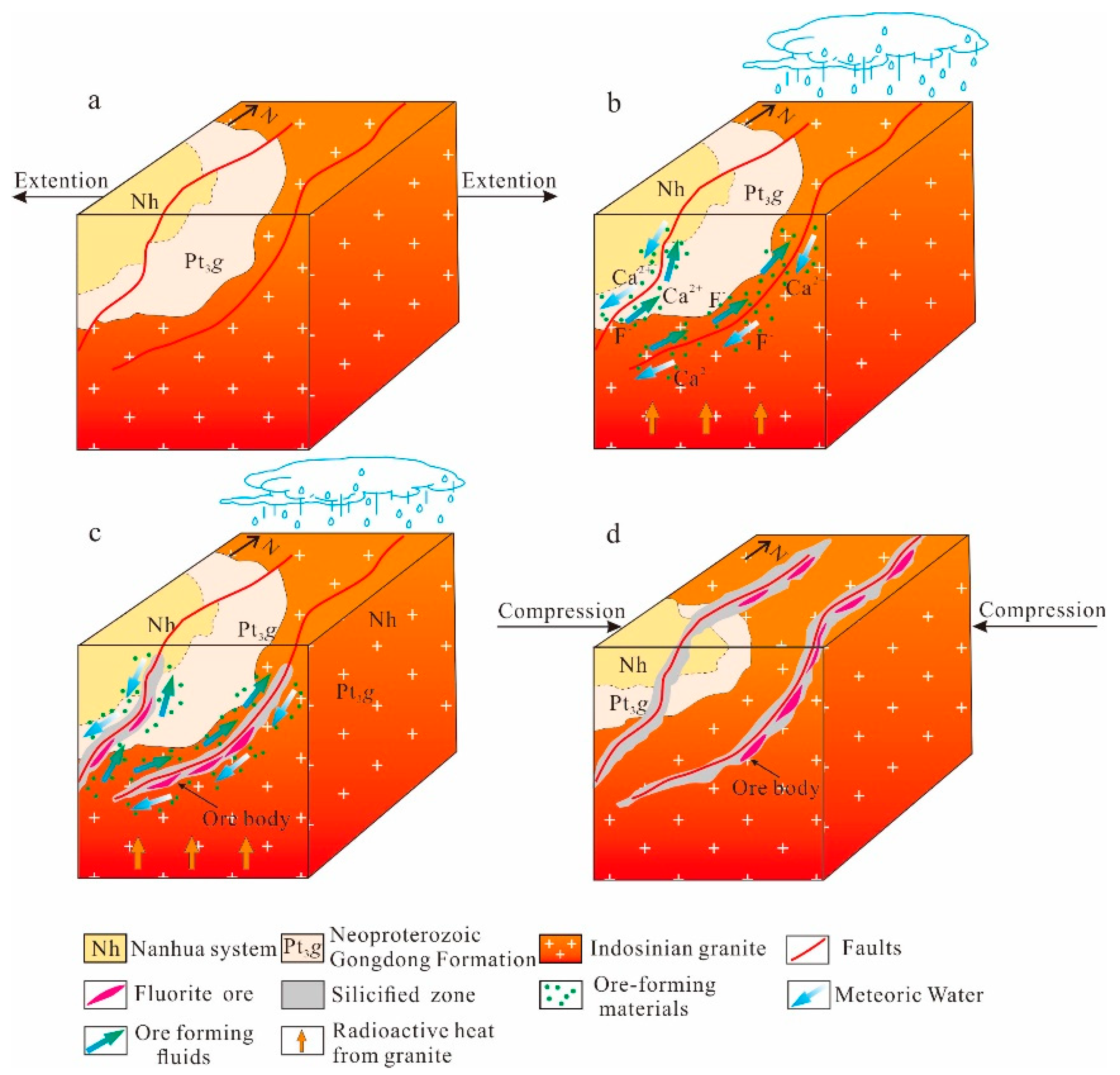
| Sample No. | Pb | Th | U | Th/U | Isotopic Ratio | Age (Ma) | ||||||||||
|---|---|---|---|---|---|---|---|---|---|---|---|---|---|---|---|---|
| ppm | ppm | ppm | 207Pb/ 206Pb | 1σ | 207Pb/ 235U | 1σ | 206Pb/ 238U | 1σ | 207Pb/ 206Pb | 1σ | 207Pb/ 235U | 1σ | 206Pb/ 238U | 1σ | ||
| SHJ02-01 | 133.2589 | 579.7773 | 2801.5330 | 0.21 | 0.0490 | 0.0008 | 0.2415 | 0.0045 | 0.0358 | 0.0003 | 146.4 | 38.9 | 219.6 | 3.7 | 226.6 | 1.7 |
| SHJ02-02 | 90.1386 | 406.4138 | 1899.8489 | 0.21 | 0.0518 | 0.0008 | 0.2557 | 0.0047 | 0.0358 | 0.0003 | 279.7 | 39.8 | 231.2 | 3.8 | 226.8 | 1.8 |
| SHJ02-03 | 168.3155 | 515.4619 | 3773.9210 | 0.14 | 0.0490 | 0.0006 | 0.2418 | 0.0038 | 0.0357 | 0.0003 | 150.1 | 34.3 | 219.9 | 3.2 | 226.4 | 1.7 |
| SHJ02-04 | 116.5695 | 647.0572 | 2412.6369 | 0.27 | 0.0491 | 0.0007 | 0.2427 | 0.0045 | 0.0359 | 0.0004 | 153.8 | 35.2 | 220.7 | 3.7 | 227.2 | 2.4 |
| SHJ02-05 | 157.6004 | 694.4251 | 3417.2607 | 0.20 | 0.0503 | 0.0013 | 0.2446 | 0.0064 | 0.0351 | 0.0003 | 205.6 | 93.5 | 222.1 | 5.2 | 222.1 | 2.1 |
| SHJ02-06 | 131.5342 | 486.6573 | 2941.5113 | 0.17 | 0.0515 | 0.0027 | 0.2499 | 0.0141 | 0.0352 | 0.0005 | 261.2 | 88.0 | 226.5 | 11.5 | 223.2 | 3.1 |
| SHJ02-07 | 130.0629 | 542.3795 | 2669.1936 | 0.20 | 0.0525 | 0.0014 | 0.2598 | 0.0076 | 0.0360 | 0.0004 | 309.3 | 56.5 | 234.5 | 6.2 | 227.9 | 2.3 |
| SHJ02-08 | 194.9586 | 507.7541 | 4476.4200 | 0.11 | 0.0526 | 0.0028 | 0.2493 | 0.0094 | 0.0352 | 0.0004 | 322.3 | 120.4 | 226.0 | 7.7 | 222.7 | 2.7 |
| SHJ02-09 | 123.0323 | 1129.8588 | 1905.4986 | 0.59 | 0.0512 | 0.0010 | 0.2462 | 0.0055 | 0.0349 | 0.0003 | 255.6 | 44.4 | 223.5 | 4.5 | 221.3 | 1.9 |
| SHJ02-10 | 79.6681 | 494.8844 | 1675.7450 | 0.30 | 0.0498 | 0.0012 | 0.2420 | 0.0071 | 0.0357 | 0.0005 | 183.4 | 55.5 | 220.0 | 5.8 | 226.3 | 3.2 |
| SHJ02-11 | 119.2085 | 540.4042 | 2477.1182 | 0.22 | 0.0481 | 0.0009 | 0.2335 | 0.0056 | 0.0357 | 0.0003 | 105.6 | 44.4 | 213.1 | 4.6 | 226.2 | 1.9 |
| SHJ02-12 | 204.6999 | 936.1752 | 4278.2541 | 0.22 | 0.0492 | 0.0010 | 0.2356 | 0.0061 | 0.0354 | 0.0003 | 166.8 | 50.9 | 214.8 | 5.1 | 223.9 | 1.7 |
| SHJ02-13 | 167.6420 | 840.1791 | 3399.2245 | 0.25 | 0.0481 | 0.0011 | 0.2328 | 0.0069 | 0.0359 | 0.0003 | 105.6 | 51.8 | 212.5 | 5.7 | 227.2 | 1.8 |
| SHJ02-14 | 129.4213 | 678.5830 | 2529.7520 | 0.27 | 0.0491 | 0.0012 | 0.2363 | 0.0079 | 0.0359 | 0.0003 | 153.8 | 59.3 | 215.4 | 6.5 | 227.1 | 2.0 |
| SHJ02-15 | 73.7076 | 337.4063 | 1502.4565 | 0.22 | 0.0549 | 0.0016 | 0.2636 | 0.0103 | 0.0358 | 0.0004 | 405.6 | 66.7 | 237.6 | 8.3 | 227.0 | 2.3 |
| SHJ02-16 | 196.5075 | 682.6729 | 4395.8731 | 0.16 | 0.0488 | 0.0014 | 0.2359 | 0.0088 | 0.0359 | 0.0003 | 139.0 | 69.4 | 215.1 | 7.3 | 227.2 | 2.0 |
| SHJ02-17 | 179.4640 | 1073.9555 | 3461.4715 | 0.31 | 0.0516 | 0.0011 | 0.2480 | 0.0071 | 0.0354 | 0.0003 | 333.4 | 48.1 | 224.9 | 5.7 | 224.5 | 1.9 |
| SHJ02-18 | 131.0549 | 1095.9131 | 2270.8162 | 0.48 | 0.0501 | 0.0021 | 0.2448 | 0.0115 | 0.0360 | 0.0004 | 211.2 | 100.0 | 222.4 | 9.4 | 227.9 | 2.2 |
| SHJ02-19 | 369.4832 | 1710.3424 | 7678.5564 | 0.22 | 0.0522 | 0.0009 | 0.2561 | 0.0058 | 0.0358 | 0.0003 | 294.5 | 37.0 | 231.5 | 4.7 | 227.1 | 1.8 |
| SHJ02-20 | 116.8691 | 596.4134 | 2397.4183 | 0.25 | 0.0485 | 0.0009 | 0.2378 | 0.0052 | 0.0359 | 0.0003 | 120.5 | 44.4 | 216.6 | 4.2 | 227.7 | 1.9 |
| SHJ02-21 | 176.5587 | 847.3381 | 3695.4754 | 0.23 | 0.0483 | 0.0009 | 0.2346 | 0.0047 | 0.0354 | 0.0003 | 122.3 | 47.2 | 214.0 | 3.9 | 224.3 | 1.7 |
| SHJ02-22 | 153.2807 | 710.8612 | 3166.1446 | 0.22 | 0.0483 | 0.0008 | 0.2386 | 0.0045 | 0.0359 | 0.0003 | 122.3 | 40.7 | 217.3 | 3.7 | 227.2 | 1.8 |
| SHJ02-23 | 196.6776 | 701.1350 | 4246.8510 | 0.17 | 0.0491 | 0.0008 | 0.2408 | 0.0045 | 0.0358 | 0.0006 | 150.1 | 40.7 | 219.0 | 3.7 | 227.0 | 3.5 |
| SHJ02-24 | 179.9275 | 1071.4967 | 3487.9823 | 0.31 | 0.0496 | 0.0007 | 0.2456 | 0.0042 | 0.0359 | 0.0003 | 176.0 | 35.2 | 223.0 | 3.4 | 227.2 | 1.7 |
| SHJ02-25 | 296.8654 | 767.3896 | 6829.8407 | 0.11 | 0.0496 | 0.0005 | 0.2457 | 0.0035 | 0.0359 | 0.0003 | 176.0 | 30.6 | 223.0 | 2.8 | 227.2 | 1.7 |
| SHJ02-26 | 94.7876 | 852.0394 | 1539.3310 | 0.55 | 0.0487 | 0.0010 | 0.2371 | 0.0050 | 0.0354 | 0.0003 | 200.1 | 50.9 | 216.0 | 4.1 | 224.2 | 1.8 |
| SHJ02-27 | 133.8424 | 471.9002 | 2911.6928 | 0.16 | 0.0505 | 0.0014 | 0.2486 | 0.0063 | 0.0358 | 0.0003 | 216.7 | 64.8 | 225.5 | 5.1 | 226.8 | 1.9 |
| Sample No. | Sm (ppm) | Nd (ppm) | 147Sm/144Nd | 143Nd/144Nd | Error (2σ) |
|---|---|---|---|---|---|
| SHJ02-A | 0.556 | 4.14 | 0.0813 | 0.511887 | 0.000017 |
| SHJ03-A | 2.21 | 8.75 | 0.1526 | 0.511966 | 0.000009 |
| SHJ03-C | 2.28 | 9.02 | 0.1525 | 0.511976 | 0.000007 |
| SHJ04-A | 0.599 | 4.1 | 0.0882 | 0.511894 | 0.000006 |
| Samples | SHJ01 Fluorite | SHJ02 Fluorite | SHJ03 Fluorite | SHJ04 Fluorite | SHJ11 Granite | SHJ12-1 Granite | SHJ12-2 Granite | SHJ12-3 Granite | SHJ12-4 Granite |
|---|---|---|---|---|---|---|---|---|---|
| La | 10.55 | 6.00 | 7.06 | 22.64 | 21.16 | 26.97 | 34.02 | 33.05 | 26.29 |
| Ce | 22.45 | 12.47 | 14.72 | 52.6 | 46.67 | 56.90 | 68.97 | 66.87 | 55.38 |
| Pr | 2.89 | 1.37 | 1.84 | 6.63 | 5.48 | 6.34 | 7.54 | 7.49 | 6.52 |
| Nd | 12.25 | 4.54 | 7.62 | 24.6 | 20.24 | 25.89 | 28.43 | 31.38 | 22.36 |
| Sm | 3.17 | 0.86 | 1.98 | 4.95 | 4.56 | 5.20 | 6.22 | 6.40 | 4.95 |
| Eu | 0.45 | 0.14 | 0.28 | 0.74 | 0.40 | 0.37 | 0.37 | 0.44 | 0.61 |
| Gd | 3.41 | 0.75 | 1.94 | 4.14 | 3.66 | 3.82 | 4.88 | 4.73 | 3.74 |
| Tb | 0.58 | 0.12 | 0.32 | 0.63 | 0.65 | 0.60 | 0.77 | 0.71 | 0.61 |
| Dy | 3.13 | 0.58 | 1.69 | 2.9 | 3.23 | 2.72 | 3.59 | 3.14 | 2.81 |
| Ho | 0.65 | 0.11 | 0.34 | 0.53 | 0.66 | 0.50 | 0.68 | 0.55 | 0.53 |
| Er | 1.65 | 0.26 | 0.82 | 1.34 | 1.69 | 1.33 | 1.81 | 1.44 | 1.39 |
| Tm | 0.26 | 0.04 | 0.13 | 0.21 | 0.27 | 0.19 | 0.27 | 0.21 | 0.21 |
| Yb | 1.60 | 0.26 | 0.76 | 1.36 | 1.66 | 1.24 | 1.64 | 1.27 | 1.23 |
| Lu | 0.24 | 0.04 | 0.11 | 0.21 | 0.24 | 0.18 | 0.23 | 0.18 | 0.18 |
| Y | 39.86 | 4.99 | 19.21 | 30.13 | 19.17 | 14.81 | 18.92 | 16.00 | 14.54 |
| ΣREE | 63.26 | 27.55 | 39.62 | 123.48 | 110.57 | 132.26 | 159.43 | 157.88 | 126.82 |
| LREE | 51.76 | 25.39 | 33.5 | 112.17 | 98.51 | 121.68 | 145.56 | 145.64 | 116.12 |
| HREE | 11.51 | 2.16 | 6.12 | 11.32 | 12.06 | 10.58 | 13.87 | 12.24 | 10.70 |
| LREE/ HREE | 4.5 | 11.75 | 5.47 | 9.91 | 8.17 | 11.50 | 10.49 | 11.89 | 10.85 |
| (La/Yb)N | 4.74 | 16.31 | 6.65 | 11.96 | 9.14 | 15.63 | 14.85 | 18.73 | 15.36 |
| (La/Sm)N | 2.15 | 4.49 | 2.30 | 2.95 | 3.00 | 3.35 | 3.53 | 3.33 | 3.43 |
| (Gd/Yb)N | 1.77 | 2.35 | 2.11 | 2.52 | 1.83 | 2.55 | 2.46 | 3.09 | 2.52 |
| δEu | 0.42 | 0.53 | 0.43 | 0.50 | 0.29 | 0.25 | 0.20 | 0.23 | 0.42 |
| δCe | 1.00 | 1.06 | 1.00 | 1.05 | 1.04 | 1.03 | 1.01 | 1.00 | 1.01 |
| F | - | - | - | - | 0.30 | 0.14 | 0.12 | 0.13 | 0.13 |
| CaO | - | - | - | - | 0.30 | 0.53 | 0.78 | 0.87 | 0.51 |
| Sample | Mineral | Type | Counts | Vapor/Liquid (%) | Freezing Point (°C) | Homogenization Temperature (°C) | Salinity (%) |
|---|---|---|---|---|---|---|---|
| SHJ01 | Fluorite | L + V | 9 | 20~25 | −0.1~−1.3 | 140~185 | 0.18~2.23 |
| SHJ02 | Fluorite | L + V | 21 | 20~30 | −0.1~−5.0 | 155~281 | 0.16~7.86 |
| SHJ03 | Fluorite | L + V | 9 | 25~35 | −0.1~−1.4 | 153~210 | 0.18~2.40 |
| SHJ04 | Fluorite | L + V | 11 | 20~30 | −0.2~−2.7 | 126~264 | 0.35~4.48 |
| Sample No | Mineral | δDV-SMOW/‰ | δ18OV-SMOW/‰ |
|---|---|---|---|
| SHJ01 | fluorite | −23.9 | −5.7 |
| SHJ03 | fluorite | −23.5 | −6.1 |
| SHJ0 | fluorite | −17.35 | −5.2 |
| SHJ07 | fluorite | −21.3 | −5.2 |
Publisher’s Note: MDPI stays neutral with regard to jurisdictional claims in published maps and institutional affiliations. |
© 2022 by the authors. Licensee MDPI, Basel, Switzerland. This article is an open access article distributed under the terms and conditions of the Creative Commons Attribution (CC BY) license (https://creativecommons.org/licenses/by/4.0/).
Share and Cite
Li, G.; Fang, G.; Feng, Z.; Xu, C.; Huang, Z.; Wang, C. Genetic Relationship between Granite and Fluorite Mineralization in the Shuanghuajiang Fluorite Deposit, Northern Guangxi, South China: Evidence from Geochronology, REE, and Fluid Geochemistry. Minerals 2022, 12, 1102. https://doi.org/10.3390/min12091102
Li G, Fang G, Feng Z, Xu C, Huang Z, Wang C. Genetic Relationship between Granite and Fluorite Mineralization in the Shuanghuajiang Fluorite Deposit, Northern Guangxi, South China: Evidence from Geochronology, REE, and Fluid Geochemistry. Minerals. 2022; 12(9):1102. https://doi.org/10.3390/min12091102
Chicago/Turabian StyleLi, Gen, Guicong Fang, Zuohai Feng, Cheng Xu, Zhennan Huang, and Chunzeng Wang. 2022. "Genetic Relationship between Granite and Fluorite Mineralization in the Shuanghuajiang Fluorite Deposit, Northern Guangxi, South China: Evidence from Geochronology, REE, and Fluid Geochemistry" Minerals 12, no. 9: 1102. https://doi.org/10.3390/min12091102
APA StyleLi, G., Fang, G., Feng, Z., Xu, C., Huang, Z., & Wang, C. (2022). Genetic Relationship between Granite and Fluorite Mineralization in the Shuanghuajiang Fluorite Deposit, Northern Guangxi, South China: Evidence from Geochronology, REE, and Fluid Geochemistry. Minerals, 12(9), 1102. https://doi.org/10.3390/min12091102




